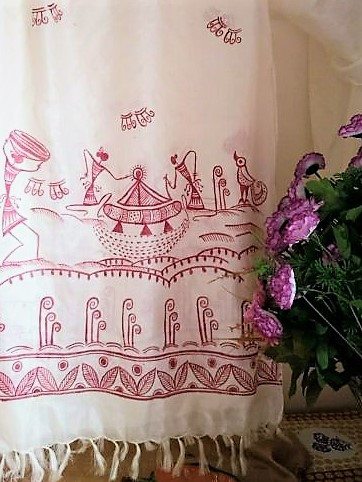Originally called ‘Kosa silk’ in Sanskrit, Indian tussar, also known as ‘tropical tussar’ is an exclusive fabric manufactured in the country. Tussar silk exhibits a rich texture and its natural gold colour makes it parallel to a natural treasure. India is the second-largest producer of this fabric with the Bhagalpur district of Bihar standing at the peak having the largest amount of tussar silk being manufactured. The history of ‘Bhagalpuri Silk’ traces back to almost 200 years ago, when the highly skilled craftsmen initiated an innovative way of dyeing the fabric. This unique technique of dyeing is what sets them apart.
Gradually, Jharkhand has also come up with a large number of tussar silk production. It is the Kharsawa district of this state that houses numerous experienced tribal workers who have engaged themselves in passing their craftsmanship down the generations. Other regions that produce tussar silk include the Malda districts of West Bengal, parts of Madhya Pradesh, Chattisgarh, and Orissa.
History of Tussar Silk
Embedded its roots in the medieval times, tussar shares its antiquity with raw silk production, which has been the forte of the tribal people residing in the Eastern part of the country. Generally, it is the women of the tribes who have employed themselves in making the yarn. They are highly skilled at their work and their steadfast dedication allows them to deliver what we see in the markets. Their proficiency, insight, storehouse of knowledge, and unparalleled technique are remarkable and distinctive in their way and it cannot be replicated.
Techniques Used In Producing Tussar Silk
Tussar silk prides itself on its distinctive and unique charm. Tussar silk is fabricated from the larvae of several species of silk moths, scientifically known as ‘Antheraea Paphia’, part of the Emperor Moths or ‘Saturnids’. Fascinatingly these moths bear circular markings on them that render them a mirror-like appearance.
These silkworms breathe in the wild forests and although mulberry is the commonest source of nutrition for most silkworms, they do not breed on them. This is the reason why the silk extracted from these oval, single-shelled cocoons earns the name, ‘wild silk’. They are boiled by the professional tribal workers and as a result, produce thin and natural golden-coloured threads.
After washing the raw silk skeins thoroughly, they are then segregated based on their size and length. The skeins are then dried and placed on reels where they are rolled onto the bobbins. After doubling the strands, they are twisted according to the kind of silk yarns. The filament is further weaved, and those weaved fabrics are dyed or printed accordingly. To enhance the appearance and texture, and to provide longevity, finishing processes are carried out by the workers. Silk creases are also removed from the finished fabric rendering a fine, fault-free and lustrous fabric.
Challenges Faced by the Workers
Sericulture stands as one of the most sustainable income sources and hence the makers, despite all the challenges, take up the work of delivering blemish-free thread. It is also interesting to note that to produce a 10-metre of tussar silk cloth, the labourers have to deliver three days of hard work.
The processes of rearing, boiling, weaving and finishing confer numerous challenges and health hazards for the workers in this field. The commonest of them are reduction in clear eyesight, increased joint pains and back aches, anxiety, and strain that arise mostly due to weaving.
In order to loosen the fibers, the cocoons are submerged in hot water with temperature ranging from 450-650 degree Celsius. At those times, the reelers are supposed to immerse their bare hands into the hot water to collect the silk threads. Undoubtedly, this results in blisters in hands, which further leads to severe infectious diseases, like dermatitis, among the female workers. Facial swelling, ocular inflammation, and skin allergies can also be noticed among them.
Tussar Silk Today
Tussar silk, like all other Indian woven fabrics, encountered a severe blow during the Industrial Revolution. However, multiple eminent personalities have patronised the fabric over the years.
But even then, tussar suffers similar troubles as other weaves. Nonetheless, in the hands of today’s leading designers like Sabyasachi and Manish Malhotra, this fabric has been experimented with and its unique charm is recognized all over again.
Today, we find the usage of tussar silk in various forms. In Orissa, the fabric is widely utilised for pattachitras, whereas West Bengal uses it for kantha stitches and Bihar for Madhubani art. Various forms of arts can also be observed in states like Chhattisgarh and Madhya Pradesh.
Traditionally, tussar silk was mostly utilised in making sarees. But today, it has been embraced in various forms, starting from sarees to kurtas, and stoles. Tussar radiates grace and elegance in every fashion form.
Picture Source: ArtsofIndia



